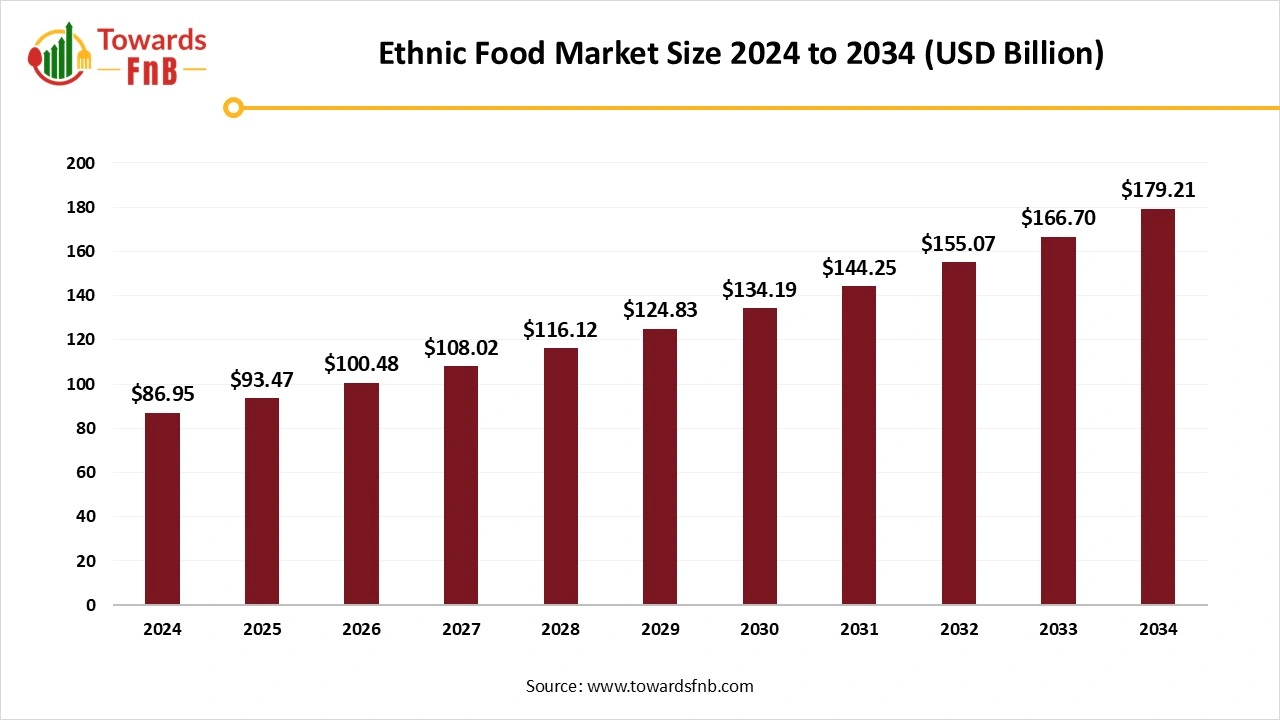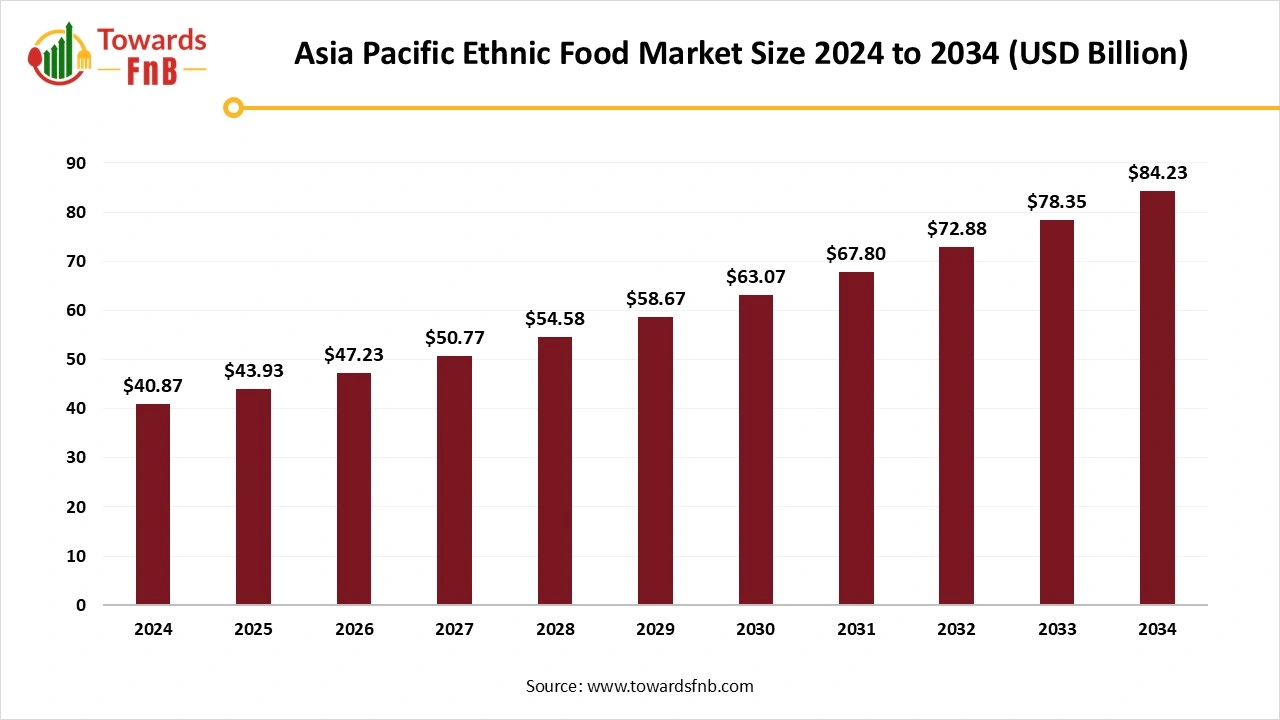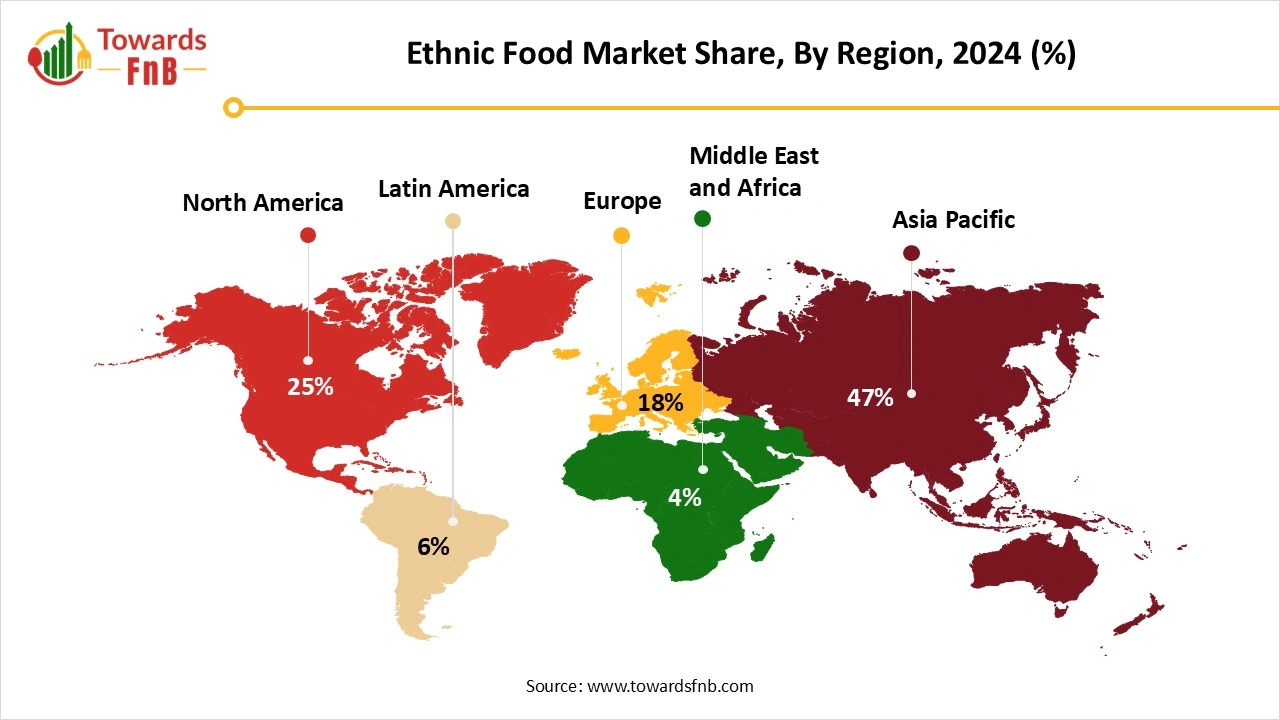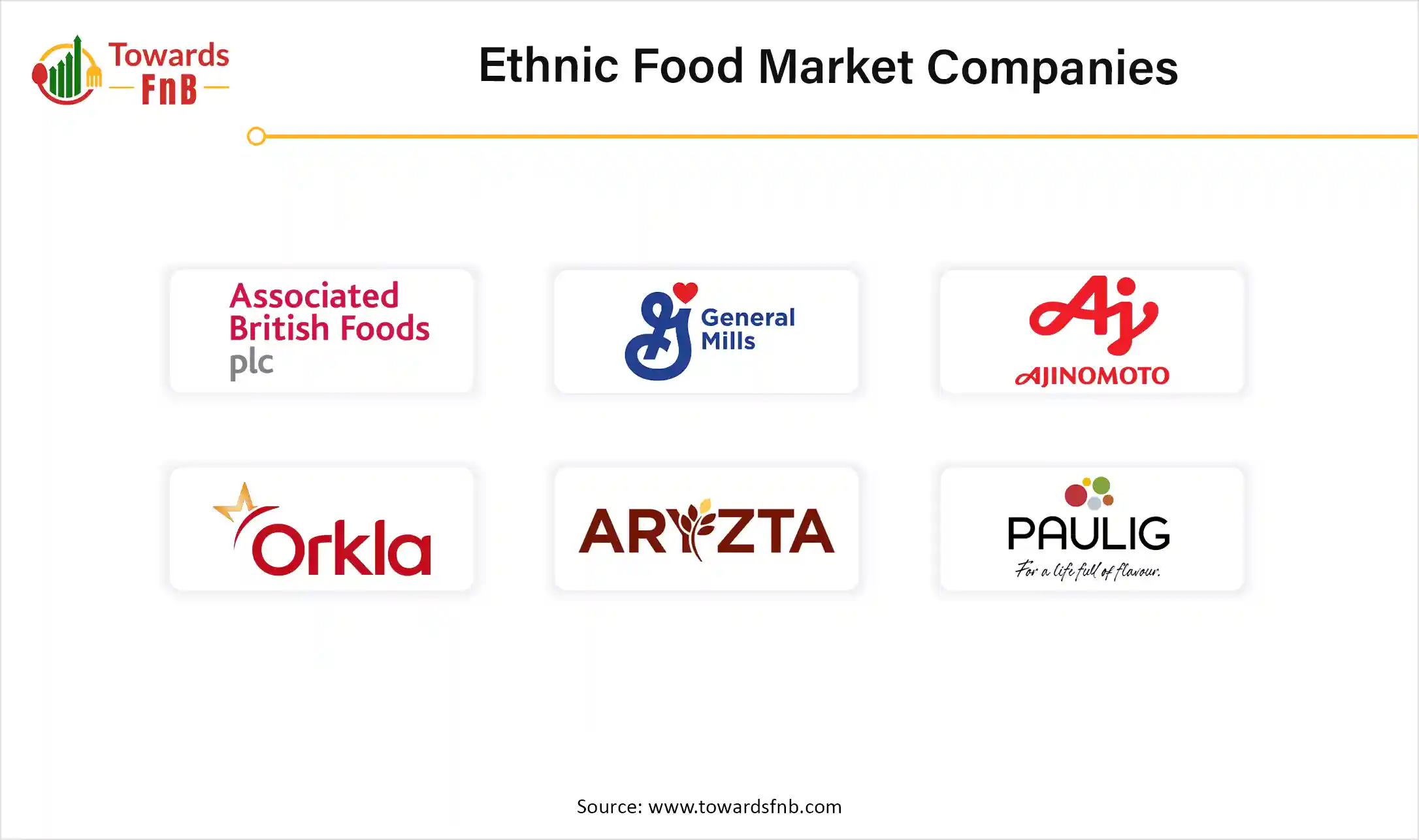December 2025
The global ethnic food market size reached at USD 86.95 billion in 2024 with projections indicating a rise from USD 93.47 billion in 2025 to approximately USD 179.21 billion by 2034, expanding at a CAGR of 7.5% throughout the forecast period from 2025 to 2034. The inclination towards the ethnic or traditional food type and the innovation in the fusion food drives the growth of the market.

| Study Coverage | Details |
| Growth Rate from 2025 to 2034 | CAGR of 7.5% |
| Market Size in 2025 | USD 93.47 Billion |
| Market Size in 2026 | USD 100.48 Billion |
| Market Size by 2034 | USD 179.21 Billion |
| Largest Market | Asia pacific |
| Base Year | 2024 |
| Forecast Period | 2025 to 2034 |
| Regions Covered | North America, Europe, Asia-Pacific, Latin America, and Middle East & Africa |
Ethnic foods are characterized by individuals outside the respective ethnic groups as culinary traditions that arise from the heritage and culture of ethnic communities. For Instance, Chinese cuisine, Mexican cuisine, Italian cuisine, and so on, are viewed as ethnic foods only beyond their own nations. Market participants aim to broaden their product ranges in all areas by introducing local food items into global markets. Creative marketing approaches are anticipated to enhance the global presence of manufacturers and provide them with profitable chances in marketing and selling local ethnic cuisine throughout the predicted timeframe. Moreover, the heightened frequency of travel will aid in market expansion by attracting more visitors to local ethnic dining establishments.
Health awareness is an aspect that the industry increasing the market. This is due to consumers incorporating these practices into their everyday lives while also requesting such food products. Thus, ethnic cuisines satisfy this by incorporating fresh ingredients, plant-based choices, and traditional cooking techniques. As an increasing number of individuals from diverse cultures move to city areas, the demand for genuine cuisines from their native lands is rising. This has resulted in a surge of ethnic eateries and food trucks providing a wide range of options from classic Ethiopian injera to Korean BBQ. These venues serve the local immigrant populations while also drawing a broader crowd interested in discovering new tastes and experiences.
As the need for traditional ethnic cuisine keeps rising, these countries are also being introduced to a variety of new ethnic foods and are becoming acknowledged in international markets. Consumers are increasingly adventurous in their food selections, looking for bold tastes and distinctive dishes. This craving for diversity has sparked interest in ethnic cuisines from areas like Asia, Latin America, the Middle East, and Africa. The growth of e-commerce and online food delivery platform is another key factor driving market expansion. People are increasingly using online platforms to find and order ethnic foods, facilitating their access to niche items that might not be present in local grocery stores.
There exists the possibility of cultural insensitivity or falsification in the promotion and preparation of ethnic cuisines. If dishes are not shown genuinely, it may result in negative reactions from consumers and hamper the growth for ethnic food market.
In the ethnic food industry, the raw material procurement deals with strategic procedure of purchasing, evaluating, processing, sourcing and packaging of nutritional and convenient ethnic food products from the various natural, plant-based, natural and clean-label foods.
Branding and Packaging for global ethnic food market focuses on creating packaging which may ensures remain stable, safe and fresh by protecting them from contamination, light and moisture.
The waste management and recycling of ethnic food focus on the health and wellness of consumers seeking convenience and ready-to-eat into nutritious, sustainable and food products.
Asia Pacific Dominated the Ethnic Food Market in 2024.
The Asia Pacific ethnic food market size was calculated at USD 40.87 billion in 2024 with projections indicating a rise from USD 43.93 billion in 2025 to reach approximately USD 84.23 billion by 2034, expanding at a CAGR of 7.5% throughout the forecast period from 2025 to 2034.

The rise in the middle class demographic and swift urban development with the ongoing economic growth in the region, a rising number of individuals are relocating to urban centers that offer greater exposure to varied cultures and cuisines. Chinese cuisine held the ethnic foods market due to its extensive popularity worldwide. This cuisine is notable for its diverse selection of ingredients, cooking techniques, and styles originating from various regions of China. The region consists of the number of traditions and food cuisines in the different countries accelerate the growth of the market.
China is a major player in the regional market, contributing to the growth due to the country's rapid urbanization, growing middle-class population, and well-established food service industry. The growing Western food influence, globalization, and consumer preference in exploring novel cuisines are driving the market growth.
India is a significant player in the regional market, growth driven by rapid urbanization, a large consumer population, and rising disposable income. The growing consumer demand for authentic regional flavors and social media influence, and trends are dominating the Indian ethnic food sector. Additionally, the growing shift toward desi cuisine and local food service industry investments in diversity are fostering this growth.
North America Expects a Significant Growth in the Ethnic Food Market During the Forecast Period.
As the population grows more diverse, consumers are more frequently in search of genuine culinary experiences that showcase various cultural traditions. Trends show that both classic and fusion ethnic cuisines are becoming increasingly popular. The increasing impact of celebrity chefs and culinary media is one of the main elements propelling market expansion throughout the United States. Culinary programs, food documentaries, and the endorsement of various cuisines by celebrity chefs have sparked interest and curiosity in audiences, motivating them to discover and sample ethnic foods. The number of food companies are investing on the research on the innovations in the ethnic food and the inclination of people towards the ethnic or traditional food type drives the growth of the market.
The U.S. is a major player in the regional market, contributing to growth due to increased immigration and the rising popularity of fusion cuisine. The easy accessibility and widespread availability of ethnic food in mainstream retail channels and online retail acceptance are contributing to this market growth.

How is Europe Driving the Ethnic Food Market?
Europe is expected to grow at a notable rate during the forecast period. The ethnic food industry in Europe is driven by increasing demand for plant-based and health-conscious options, increasing consumer preference towards culinary exploration, and growing multicultural populations. France, Germany and UK are the major economics fueling the market growth.
The Germany Ethnic Food Market Trends
The global market in the UK is driven by the increasing need for convenient meal solutions, increasing busy lifestyles, increasing consumer preference towards natural and healthy food options, and increasing global travel and multiculturalism across the globe.
How is the Middle East and Africa Driving the Ethnic Food Market?
The ethnic food industry in the region is driven by factors such as the rise of e-commerce platforms, increasing consumer preference towards cultural food, increasing demand for migration and convenient options, and growing rapid urbanization.
South Africa Ethnic Food Market Trends
The ethnic food industry growth in the country is driven by factors such as increasing demand for plant-based, ready-to-eat and healthy food options, increasing international travel, convenience, and increasing consumer interest in cultural exchange and diverse flavors.
Why is South America Driving the Ethnic Food Market in 2024?
The South America ethnic food industry is driven by the increasing demand for both health-focused and traditional variations, increasing interest in health-conscious eating, expansion of food delivery and e-commerce platforms and increasing international travel and multiculturalism platform.
Mexico Ethnic Food Market Trends
The market growth in Mexico is driven by increasing demand for plant-based and organic options, increasing popularity of food delivery services and convenience foods, increasing consumer demand for bold and diverse flavors and rising multiculturalism.
Asian Segment Held the Largest Share in the Ethnic Food Market in 2024.
A significant reason for the rising popularity of Asian cuisine is the growing recognition and admiration for genuine ethnic tastes. Asian fusion cuisine provides chefs with a platform for creativity to craft unforgettable dishes featuring a variety of flavors and textures, while food lovers appreciate the cultural diversity and exchange of influences.
The mexican segment is projected to show remarkable growth in the projection period. From sunlit vacation spots to ancient origins, Mexican food presents a variety of tasty meals. Savor the lively hues and tastes of this classic cuisine, turning it into an unforgettable draw for culinary enthusiasts around the globe.
The Non-Veg Segment Dominated the Ethnic Food Market in 2024.
Worldwide, the intake of non-vegetarian foods greatly exceeds that of vegetarian foods. Therefore, the market share of non-vegetarian ethnic cuisine is also significant. The veg segment is anticipated to grow at fastest rate in the projection period. Growth is attributed to the factors like rising health awareness, concept of veganism and concern regarding animal cruelty.
The Supermarkets and Hypermarkets Segment Accounted for Largest Share in the Ethnic Food Market in 2024.
Hypermarkets and supermarkets are taking advantage of this trend by broadening their global food selections and obtaining products from diverse areas, providing consumers with convenient access to a variety of genuine ethnic ingredients. This enhancement in food variety not only serves traditional ethnic groups but also attracts adventurous diners in search of novel tastes.
The Online Segment Expects Significant Growth in the Ethnic Food Market During the Forecast Period.
E-commerce sectors have simplified the process for consumers to discover a wide variety of ethnic products that might not be easily found in traditional physical stores. This change is mainly fueled by the increasing ease and availability of online shopping, along with a more varied and tech-savvy group of consumers keen to discover unique culinary experiences from their own homes.

By Cuisine
By Food
By Distribution Channel
By Region
December 2025
December 2025
December 2025
December 2025